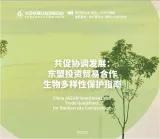China ASEAN Investment and Trade Guidelines for Biodiversity Conservation
As China’s neighboring region, Southeast Asia is a biodiversity hotspot holding about 20 percent of the global plant, animal, and marine species. However, the region’s diverse biological resources are currently under heavy threat. Foreign investment, especially Chinese overseas investment, constitutes one of the crucial factors. Chinese investments in Southeast Asia are focusing on three sectors: energy, infrastructure and agriculture. In their current form all three pose relatively high risks to biodiversity, ecosystems and local communities.
Recognizing these risks, the Chinese government has demonstrated a strong political will to address social and environmental concerns over its overseas projects. It has published several guidelines for ecological and environmental protection in overseas investment, especially for BRI projects. Turning those governmental guidelines into concrete practice, however, is far from straightforward.
With the support of the Heinrich-Böll-Stiftung Beijing Representative Office, in 2022 the Beijing Greenovation Institute for Public Welfare Development published the “China ASEAN Investment and Trade Guidelines for Biodiversity Conservation”. The guidelines connect policy-level regulations with biodiversity conservation-related projects in ASEAN. They suggest managing the biodiversity impacts of construction projects from a complete life-cycle perspective and propose concrete biodiversity protection measures for the whole investment process, including planning, construction and operation.
